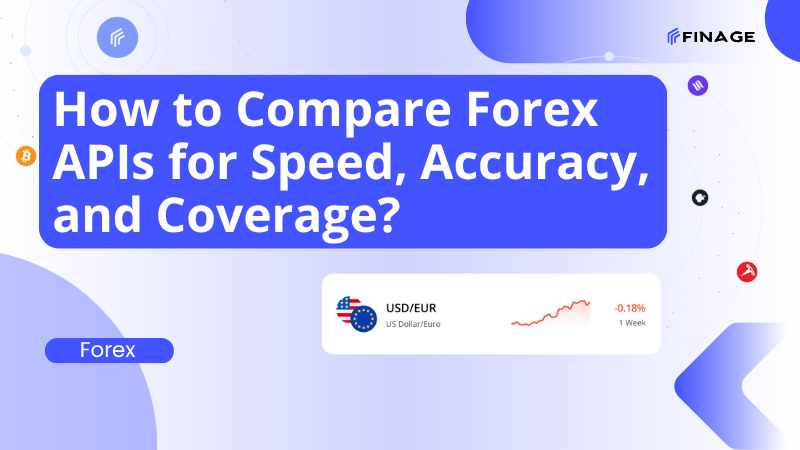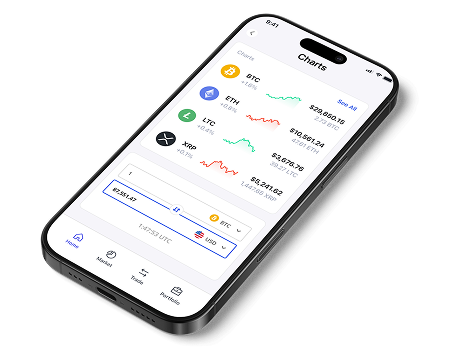How to Compare Forex APIs for Speed, Accuracy, and Coverage
6 min read • July 30, 2025

Introduction
In the fast-paced world of currency trading, data is only as valuable as it is timely, reliable, and complete. Whether you're building a forex dashboard, an algorithmic trading bot, or a global finance app, choosing the right forex API can determine the effectiveness of your entire product.
But with so many providers claiming low latency and high accuracy, how do you compare them? What metrics matter most, and how do you know which API is built to handle your needs at scale?
In this guide, we’ll break it down clearly. You’ll learn how to evaluate a forex API based on speed, precision, and market coverage, plus what makes Finage a developer-friendly solution for real-time currency data.
Table of Contents
- Understanding the Role of a Forex API
- Speed: Why Low Latency Isn’t Optional
- Accuracy: The Hidden Cost of Poor Data
- Coverage: More Pairs, More Opportunities
- How Finage Stands Out as a Forex API Provider
- Final Thoughts
1. Understanding the Role of a Forex API
At its core, a forex API serves as a bridge between real-time currency markets and the applications that depend on them. It delivers continuously updated exchange rate data, helping your product, whether it’s a trading bot, risk engine, or finance app, respond to shifting global conditions.
But a good forex API does more than stream numbers. It enables:
Price transparency: Traders and analysts need to see up-to-date bid and ask prices across currency pairs.
Data consistency: Applications must rely on standardized, stable formats across endpoints, especially for historical and live data comparison.
Automated decision-making: Trading algorithms depend on precise data for timing entry and exit points.
Global reach: Coverage across both major and exotic currency pairs ensures that you’re not flying blind when the market moves.
Ultimately, your forex API becomes a critical layer in your infrastructure. If it’s slow, unreliable, or missing markets, your decisions and your users will suffer. That’s why speed, accuracy, and coverage must be front and center when making a choice.
2. Speed: Why Low Latency Isn’t Optional
In forex trading, milliseconds matter. Exchange rates shift constantly, often driven by geopolitical news, central bank policy, or high-volume trades. If your forex API can’t deliver updates in near real time, your entire trading logic could lag behind the market.
Latency, the time it takes for data to travel from source to screen, impacts:
Execution timing: Even a 100ms delay could turn a profitable trade into a loss.
Price accuracy: Stale data means you're making decisions based on old prices.
User experience: In apps and dashboards, visible lag causes users to lose trust.
To assess latency, ask:
- Does the provider offer WebSocket feeds for real-time data?
- How close are their data centers to major forex markets?
- Do they support edge delivery via CDN infrastructure?
- Is latency performance published and benchmarked?
Fast data isn’t just a luxury; it’s foundational. If you're building for serious traders or automated systems, your forex API needs to be engineered for speed.
3. Accuracy: The Hidden Cost of Poor Data
In currency markets, data accuracy isn’t just a technical detail; it’s the backbone of trust, execution, and performance. A reliable forex API must deliver rates that closely reflect what’s happening on the actual market, across multiple liquidity sources.
Why does this matter?
Miscalculated entries: Inaccurate rates lead to missed opportunities or premature exits.
Misleading analytics: Historical data that isn’t properly aligned with true market prices skews backtesting and risk analysis.
Broken user trust: If end-users see prices that don’t match the market, or encounter frequent data gaps, they won’t return.
To evaluate accuracy in a forex API, look for:
Multiple pricing sources: Aggregation from tier-one banks, ECNs, and liquidity providers ensures consistency.
Granularity of data: Check how often prices are updated, per second? Per tick?
Error handling: Can the provider flag anomalies or missing data?
Historical integrity: Does their backdated data match real-market conditions from those timeframes?
Accuracy might be less visible than speed, but it can be far more damaging if it's missing. The best forex APIs are transparent about how their data is sourced, validated, and maintained.
4. Coverage: More Pairs, More Opportunities
Speed and accuracy are crucial, but they won’t help if your forex API doesn’t cover the pairs you need. Comprehensive coverage means you can support a wider range of trading strategies, markets, and user needs.
Strong coverage includes:
Major pairs: USD/EUR, GBP/USD, USD/JPY, are essential for almost any trading app.
Minor and cross pairs: Like AUD/CAD or EUR/CHF, which support global users and region-specific strategies.
Exotic pairs: Such as USD/TRY or ZAR/JPY, are often favored by experienced traders seeking volatility and opportunity.
Crypto-to-fiat pairs: Increasingly relevant in hybrid fintech apps that bridge traditional and digital assets.
When evaluating coverage, ask:
- How many currency pairs are available?
- Are all pairs updated at the same frequency?
- Can you access historical and intraday data for all symbols?
- Is there a clear structure for how pair data is named and retrieved?
A robust forex API doesn't limit your potential; it opens the door to global reach and market depth. If you're aiming to serve diverse users or expand internationally, coverage matters more than you think.
5. How Finage Stands Out as a Forex API Provider
Among the many data providers in the fintech space, Finage is purpose-built for developers and product teams who need a forex API that performs under pressure. What sets Finage apart isn’t just one thing; it’s the unified approach to speed, accuracy, and scale.
Here’s how Finage delivers:
Real-time, low-latency data: With robust WebSocket support and global CDN infrastructure, Finage ensures your apps stay up to the second.
Comprehensive currency coverage: From major pairs to lesser-known exotics, you get full access with consistent update intervals.
Clean, developer-friendly APIs: REST and WebSocket APIs are documented clearly, with endpoints that are predictable and easy to integrate.
Data accuracy from trusted sources: Finage aggregates from high-quality liquidity pools, helping you maintain pricing confidence.
Flexible pricing models: Whether you’re building a startup product or scaling a global platform, Finage grows with you.
And crucially, unlike many fragmented providers, Finage offers unified access to multiple asset classes beyond forex, including stocks, cryptocurrencies, and indices. That means less time spent juggling APIs and more time spent building what matters.
Final Thoughts
Choosing the right forex API is about more than just data access; it's about finding a partner that supports your long-term product vision. Whether you're building algorithmic trading tools, real-time dashboards, or educational fintech apps, your API must deliver speed, accuracy, and coverage without compromise.
Finage checks all these boxes with a developer-first approach, transparent infrastructure, and a growing ecosystem of real-time data services. Backed by unified support for multiple asset classes and designed to scale with your needs, Finage empowers you to build faster, trade smarter, and stay ahead.
If you're ready to move beyond limitations and start building with confidence, explore the full capabilities of the Finage Forex API and see how your next project can benefit from enterprise-grade market data, no overengineering required.
Relevant Asked Questions
- How do I compare forex APIs for trading bots?
To compare forex APIs for trading bots, focus on latency (speed of data delivery), accuracy (source and frequency of updates), and coverage (number and type of currency pairs). Finage provides real-time, low-latency data from multiple sources, ideal for algorithmic trading.
- Does Finage support exotic and crypto-to-fiat currency pairs?
Yes, Finage offers broad coverage including major, minor, exotic, and crypto-to-fiat pairs. This allows developers to build global applications that support diverse trading strategies and user needs.
- Why is low-latency forex data important in automated trading?
Low latency ensures that trading bots react to market changes in real time. A delay of even 100ms can lead to missed opportunities or losses. Finage uses WebSocket and CDN infrastructure to deliver real-time forex data with minimal lag.
Claim Your Free API Key Today
Access stock, forex and crypto market data with a free API key—no credit card required.

Stay Informed, Stay Ahead
Finage Blog: Data-Driven Insights & Ideas
Discover company news, announcements, updates, guides and more
.png)
.png)
.png)